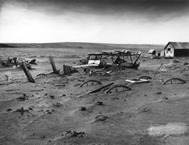Historical Patterns, The 1930s Dust Bowl Drought
 A scientific paper published last month in the journal Climate Dynamics by a scientist from NOAA’s National Climatic Data Center and three universities found that the 1930s drought was exacerbated by an anomalous warm spots in the ocean:
A scientific paper published last month in the journal Climate Dynamics by a scientist from NOAA’s National Climatic Data Center and three universities found that the 1930s drought was exacerbated by an anomalous warm spots in the ocean:
Unusually hot summer conditions occurred during the 1930s over the central United States and undoubtedly contributed to the severity of the Dust Bowl drought. We investigate local and large-scale conditions in association with the extraordinary heat and drought events, making use of novel datasets of observed climate extremes and climate reanalysis covering the past century. We show that the unprecedented summer heat during the Dust Bowl years was likely exacerbated by land-surface feedbacks associated with springtime precipitation deficits. The reanalysis results indicate that these deficits were associated with the coincidence of anomalously warm North Atlantic and Northeast Pacific surface waters and a shift in atmospheric pressure patterns leading to reduced flow of moist air into the central US. Thus, the combination of springtime ocean temperatures and atmospheric flow anomalies, leading to reduced precipitation, also holds potential for enhanced predictability of summer heat events. The results suggest that hot drought, more severe than experienced during the most recent 2011 and 2012 heat waves, is to be expected when ocean temperature anomalies like those observed in the 1930s occur in a world that has seen significant mean warming.
Similarly, a warm “blob” of ocean water is currently floating off the West coast of the U.S. And – as reported by the Washington Post, NBC News, and CBS – scientists say that the warm anomaly may be causing the California drought.
Postscript: Scientists say that the warm seawater anomalies are associated with shifts in atmospheric pressure patterns, which may – in turn – be caused by periodic fluctuations in the “Pacific decadal oscillation” or the “North Pacific mode“. And see this.
Interestingly, these patterns may, in turn, be effected by fluctuations in the output from the sun. For example, National Geographic reported in 2008:
- The sun’s fluctuations can help predict extreme climatic events on Earth decades ahead of time, new research suggests.
- The cycles, which are driven by the sun’s magnetic turbulence, may influence weather systems on Earth, particularly the El Niño-Southern Oscillation, a periodic climatic system associated with floods and droughts mostly in the Southern Hemisphere.
- The Southern Oscillation Index, which measures the El Niño-Southern Oscillation system, seems to correspond with a 90-year sun cycle, Baker found.
- Periods of greater solar disturbances are associated with rainy periods, whereas a calmer sun dovetailed with times of drought in Australia, Baker said.
- El Niño and La Niña, which creates opposite climatic effects from El Niño, also affect North America.
That means long-range forecasting is possible for water availability in Mexico and the western United States, where droughts are often severe, Baker said.
How solar cycles may influence Earth’s weather systems is not well understood, but Baker speculated that cosmic radiation is a factor.
For instance, Baker’s research shows that periods of high cosmic radiation coincide with particularly long La Niñas, Baker said.
By Washington’s Blog | Global Research, May 06, 2015 | Washington’s Blog
